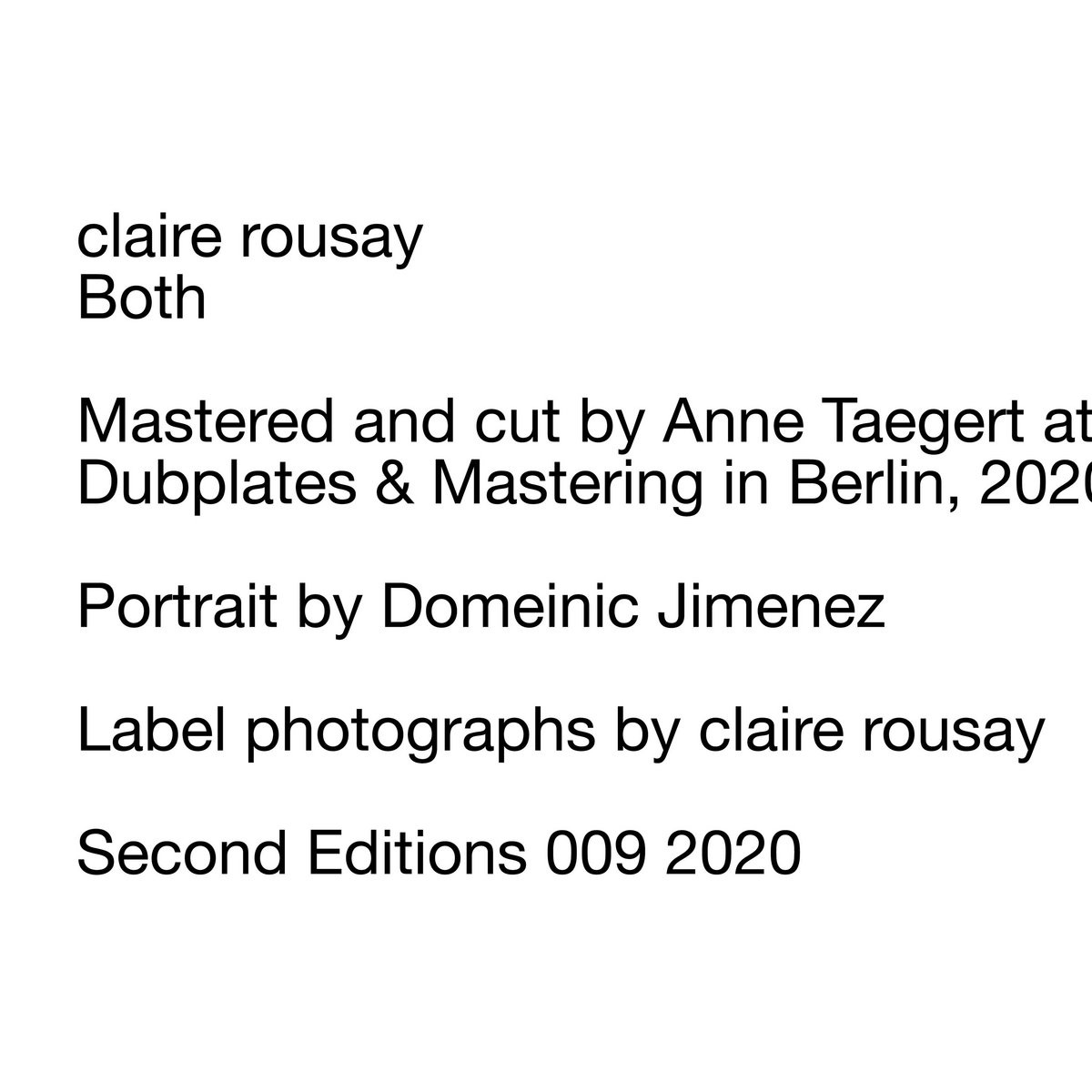Welcome to Organ Grinder, an experimental music newsletter edited by Jinhyung Kim. Every other Monday, you’ll hear what our writers have to say about a new release from the spheres of the experimental and avant-garde. Our second issue features reviews of Both, the new LP by San Antonio-based artist Claire Rousay, released August 28 on Second Editions.
Before diving in, I’d once again like to extend the invitation I made last issue: if you’re a younger, newer writer, and/or a BIPoC, woman, LGBTQ+ person, or anyone whose voice often goes unheard in media and culture writing, I’d love for you to write with us. If you want to apply, email me at organgrindermusic@gmail.com.
Round Table
Our writers’ thoughts on a new release. This section will be the core of each issue.
Claire Rousay, Both (Second Editions, 2020)
Claire Rousay is an artist and musician based in San Antonio, Texas. Her practice used to center on improvisatory percussion, but within the past couple of years, it has expanded to encompass electronics, field recordings, and broader forms of improvisation, often in collaboration. 2020 has been a prolific year for Rousay; she’s put out music solo and with Jen Hill, More Eaze, Alex Cunningham, and Carol Genetti on labels such as Already Dead Tapes, Amplify 2020, Anahuac Editions, Astral Editions, Astral Spirits, Mondoj, and now Second Editions. Her latest, Both, comprises two side-long sound collages: one rooted in a field recording of the Central Library at San Antonio (“Library”) and the other stitched from street sounds, conversation, and other ambience (“Two Things”).
Read more about Both on the Second Editions website. Purchase Both digitally on Bandcamp or physically from Anost or Forced Exposure.
Chloe Liebenthal: Do librarians ever actually say “quiet in the library,” or is that just a cliché? Genuine question here, and one I pondered pretty seriously while listening to Both, which (I think) deals with themes of connection, community, and the restorative power of silence. She skillfully elevates the detritus of daily life—unnatural stillness in libraries, half-heard snatches of music from a high-above apartment window, the noise from the world around you that creeps in when you’re just sitting around alone—to the definitive lens with which to view the way we relate to each other. Whether by a communal quietness in the library or the sounds of a busy day outside, Rousay proves that we create our sound-worlds together. As stated at the end of “Two Things,” the individual artist is not a “special person,” an agent acting totally alone, but the vessel through which an entire sonic world communicates itself.
I visited one of those anechoic chambers once and sat there listening to my own heartbeat; eventually the sound of it became too loud and I had to leave. To me, the soundscapes presented by Both present a truer form of silence—not one that exists in opposition to a so-called outside world but one that’s maintained by the collective efforts of an entire community.
Jack Ahrens: The beginning of “Library” always catches me off guard. Emerging from a drawn-out silent introduction, a subtle hiss creeps its way into frame and takes root in the backdrop of my room. The buzz of my fridge and hum of my AC, at first joined by the hushed bustle of nearby strangers, are then pushed aside for good by an impenetrable white noise that pervades every corner of this new atmosphere. It’s like slowly waking up from the monotony of everyday life, shaking off the half-conscious haze of early morning, and looking around to discover a new but unremarkable day. Except here, the ever-present mundane puts itself front and center. Voices overheard echo throughout the room, accompanied by a nearby elevator and accentuated by the distant boom of some heavy object, all joining together in a chorus that, in its wholly impersonal detachment, strikes a deeply personal note. A clear divide materializes between the listener and the tranquil but utterly disinterested comings and goings of the library. These people don’t know me, don’t acknowledge me, probably don’t even see me, and as they go about their day, I can sense that each of them feels the same alienation. And when the album ends and I take off my headphones, not much changes. Six months of quarantine in an already atomized world will do that to you.
\\
Zachariah Cook: By the midsection of “Two Things,” we have basked in Rousay's hub of spiritual expansion (“Library”) and eavesdropped on a rousing, yet subdued stream of consciousness. It’s at this point that we hear a stirring bit of piano melody. For me, it evokes a feeling of great warmth and household joy—somehow, I know I’ve ended up at a place of belonging. The rush of a plane lifting off its tarmac enters the mix. I ascend into a daydream—I may as well be napping on the couch while a loved one cooks dinner. The interiority she explores throughout Both lends itself to domestic interpretation, though I may underestimate just how intimate this work really is. Maybe for once I’m content in my aloneness. Those piano flourishes announce a revelation from deep within the heart, an ineffable truth only its keeper has the tools to understand.
Jinhyung Kim: For the first few seconds of the music video for Juice WRLD’s “Righteous,” we look out the window of a plane. Then, we hear a two-note chime; has the seatbelt sign turned on? The music (and video proper) begin, and it’s immediately clear that Jarad’s intro vocalizations echo that chime. Of course, this is just an association created in the edit by someone other than the artist himself. Still, the idea that some sanitized not-even-a-jingle lies at the root of a quite soulful piece of self-expression is genuinely captivating.
From the time I’ve spent with her work, I’m convinced Claire Rousay hears the world with the same openness to its musicality as the Juice WRLD of my imagination. While there are faint occurrences of conventional song in “Two Things”—spirited fiddle, slide guitar surf, whorls of piano—this field-recorded soup also has overheard conversations, the whir of vehicles passing by, metallic clacking, the quiet tinkling of glass. I feel like any one of these bits could blossom into its own, self-contained piece; there might be a pop rap tune in there. However, I don’t think Rousay’s in a rush to extrapolate. For now, she’s probably content looking out the window and just taking it all in.
…it’s deceptive, for sure. Because while listening, I’m not quite sure what window she’s looking out of. The thing about making art is that you can pretend that all the meaningful stuff from the past few years happened in just a few days. You get to compile, to cherry pick. When I listen to “Two Things,” I float from window to window, and sometimes I’m at more than one at once. This piece wouldn’t exist if it were no more than a window to peer out of (I’m sure Rousay has one of those at her place). Rather, it’s a window to all the windows she’s looked out of and heard things from. That’s what makes it special.
Thanks for reading this week’s issue of Organ Grinder. Feel free to share with friends and spread the word.




